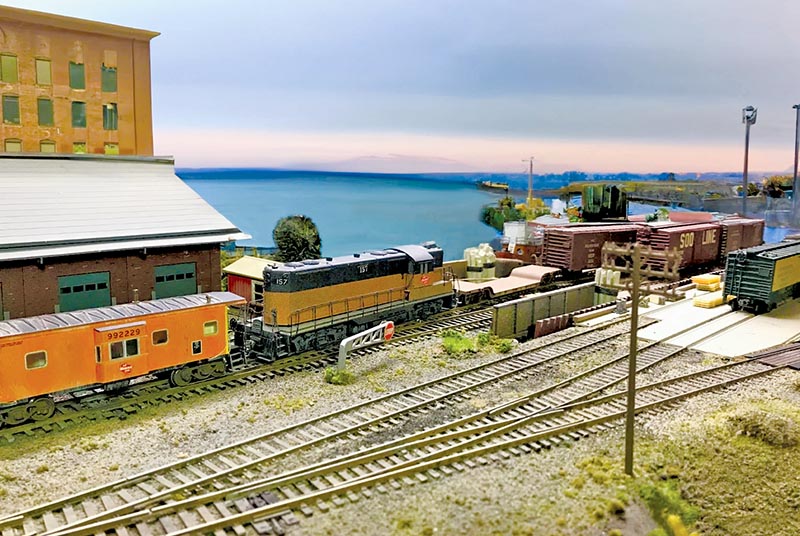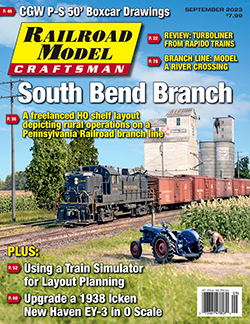“Less is more.” Sometimes it’s an overworked phrase, but it can especially apply to model railroads. Many home layouts are designed to serve multiple locations, with multiple trains, often fed by extensive staging yards, sometimes at both ends of the modeled line. While this style of operation can be quite enjoyable, many of us lack the resources to support such a layout, or simply aren’t interested in hosting large sessions with dozens of operators. Why not consider a layout that focuses on a single location?
Modeling a single town focuses your efforts in every aspect from researching a prototype location to selecting appropriate equipment. While you can convincingly create a generic-looking town, many modelers discover replicating a specific place and time to be quite rewarding. Poring over old maps reveals clues to the locations of tracks, structures and roads. Finding a photo that shows the old Acme Furniture Store that was located just across the street from the passenger station is a “Eureka!” moment. Seeing that photo in color and learning the building had a yellowish-tan brick in the era you model simply makes your day and is part of the fun of discovery.
Focusing on a single location isn’t meant to imply that you will be faced with “simple” construction of “boring” scenery. Your location could be a small town on the prairie, a section of a busy urban switching district, or the middle of a mountain pass. Each involves specific modeling techniques to replicate, and the more you delve into your chosen location, the more you learn about how to convincingly model it. For example, I model Tacoma, Washington, in 1962 in HO scale. As I pondered the setting for my railroad, I realized I was drawn to rail-served seaports. I was also leaning toward the Pacific Northwest after visiting a family member there. Seattle seemed too big, but Tacoma seemed just right.
That choice paid off for me in many ways. The more research I did, the more it reinforced my decision, with a lot of bonuses along the way. Tacoma in my era was served by four Class I railroads including Northern Pacific, Great Northern, Union Pacific and The Milwaukee Road. Tacoma Municipal Belt Line Railroad (“the Muni” to locals) was formed to facilitate switching for the “big” railroads. Add to the mix the Port of Tacoma Railroad, and that means I can model six different lines in one area! Operating sessions reflect the prototypes. Each railroad switches its zones, drops cars for the Belt to classify, then runs transfer cuts to each railroad’s Tacoma yard and returns as a caboose hop. The Port crew works five different jobs within the confines of the port, including a wharf with 12 spots for a coastal freighter. That switcher takes its cars to an interchange track with the Belt.
Steve Hipes, a member of our local operating group, created the freelanced Columbus Belt Line set in Ohio in 1977, shortly after Conrail took over from Penn Central. While researching his HO layout, he discovered Pennsylvania Railroad proposed such a belt line around Columbus, but never built it. So Steve did as if it was being operated by Conrail. His goal is to capture the variety and spirit of industrial Columbus. None of the buildings is an exact replica, but they all reflect businesses served by the railroad.
Richard Argo worked various jobs in and around Columbus for Chesapeake & Ohio while on summer break from college. He is recreating that time in HO in his basement. While the buildings housing the various businesses and industries aren’t scale replicas of what was there, the names are the same, including signs reproduced from old photographs. One exception is the scratchbuilt C&O freight house modeled after the structure that stood in Columbus. Besides the freight house, one easily recognized feature is an area on a hillside called “the Badlands.” C&O served a number of breweries there, including Hoster Brewery, which Dick models. “We could only shove four or five cars up that grade to work the breweries,” he says, so the same holds true for his model.
You don’t need a spacious basement to model a one-town layout. A spare bedroom or even part of a room with a shelf layout can do a credible job of modeling a single location. One-town layouts work well if you like operating with a few friends or just by yourself. If switching cars or classifying cuts of cars is your interest, it’s hard to beat a one-town layout.




